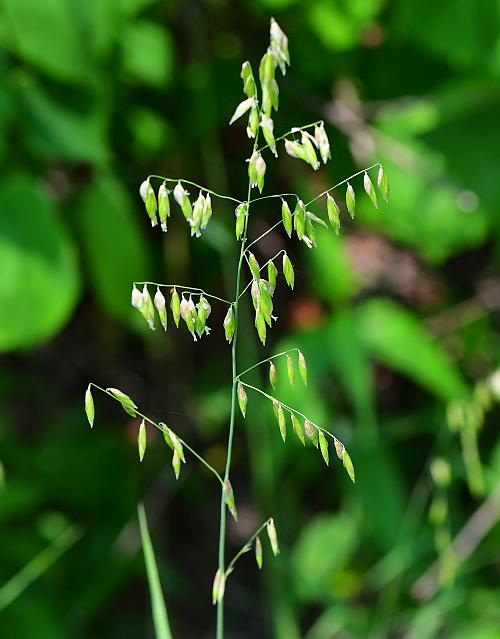Melica nitens (Scribn.) Nutt. ex Piper
Three-flowered Melic Grass, Ladd's Favorite

Native
CC = 6
CW = 5
MOC = 64
© SRTurner
Melica nitens (Scribn.) Nutt. ex PiperThree-flowered Melic Grass, Ladd's Favorite | |
 |
Native CC = 6 CW = 5 MOC = 64 |
© SRTurner |
|
Family - Poaceae/Meliceae Habit - Perennial cool-season (C3) grass with short rhizomes, forming clumps. Stem - Flowering stems 50-150 cm long, glabrous.
Leaves - Leaf sheaths closed, glabrous or sometimes roughened or hairy. Ligule membranous. Leaf blades 5-25 cm long, 3-10 mm wide, flat at maturity, glabrous or sometimes roughened or hairy.
Inflorescences - Panicles, usually with numerous spikelets.
Spikelets - Spikelets 8-15 mm long, pendant at maturity, oblong-obovate in outline, usually somewhat flattened, disarticulating below the glumes, with usually 3 fertile florets with tips at different levels and a straight, terminal structure distinctly different in appearance from the fertile florets, this consisting of 2 reduced sterile florets rolled into a small, club-shaped mass. Glumes 3-or 5-nerved, bluntly pointed at the tip, glabrous or somewhat roughened, usually with broad, thin, papery margins. Lower glume 5-8 mm long, broadly elliptic-obovate. Upper glume 7-9 mm long, ovate to obovate. Lemmas of fertile florets 7-11 mm long, narrowly to broadly ovate, rounded to bluntly pointed at the thin, papery tip, 5-9-nerved, often with additional, fainter nerves near the base, awnless, glabrous or roughened along the nerves. Paleas shorter than the lemmas, usually hairy along the nerves. Stamens 3.
Fruits - Caryopses 2.5-3.0 mm long, narrowly elliptic in outline, slightly flattened, with a shallow, longitudinal groove, yellow to greenish brown, shiny. Flowering - April - July. Habitat - Upland forest openings, upland prairies, glades, bluffs, roadsides, railroads; usually on limestone or dolomite substrates. Origin - Native to the U.S. Lookalikes - Melica mutica, which is rare in Missouri. Other info. - This charismatic grass is easily recognized by its large, fat spikelets, closed leaf sheath, and prominent membranous ligule. It occurs throughout the state. Its wider range comprises a band extending from the southern tip of Minnesota and Wisconsin south and west through southwestern Texas. It has been used as a forage crop, but in some areas it is considered threatened due to habitat fragmentation and land use practices. Photographs taken at Shaw Nature Reserve, Franklin County, MO, 5-14-2022 and 5-17-2023 (SRTurner). |